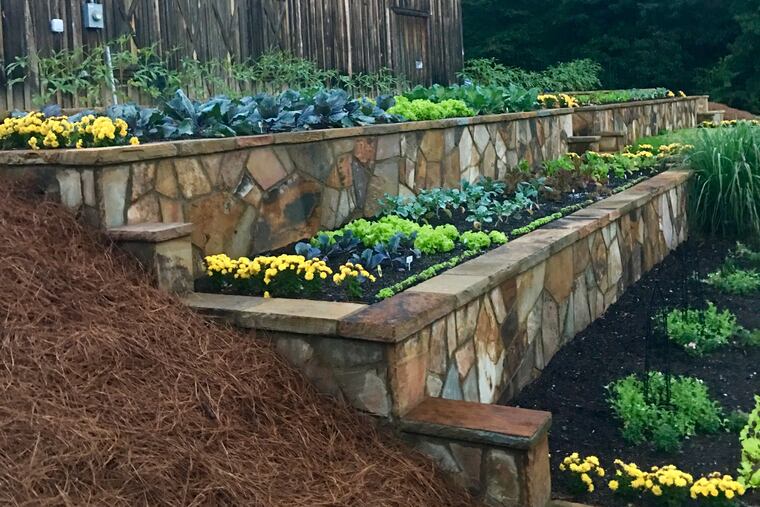Garden basics: What is an annual? What is a perennial? And why does it matter?
“If you like to eat, you have to grow annuals,” one expert said. “But there’s definitely a movement now toward having a balance of annuals and perennials in the vegetable garden.”

An annual is a plant that lives and dies in one growing season. A perennial regrows year after year.
In our busy world, why plant anything but perennials?
Because annuals are the backbone of our edible plants, said professional gardener Lauri Kranz, owner of Edible Gardens L.A.
“If you like to eat, you have to grow annuals,” Kranz said. “But there’s definitely a movement now toward having a balance of annuals and perennials in the vegetable garden.”
When you go to nurseries, check the label to determine whether a plant is an annual or a perennial or ask for assistance. Most shrubs and native plants are perennials, although some, including native wildflowers, are annuals that reseed every year once they are established. Many flowers and vegetables are annuals that put everything into producing flowers, fruit and seed in a single season.
Perennials
Edible perennials include blueberries, asparagus, rhubarb, fruit trees and vines (grapes, for example), berry plants and woodier herbs such as sage, thyme, rosemary, marjoram and oregano.
“Once established, they require less care, day in and day out, than annual vegetables,” Kranz said, “and they are heartier, as a rule. You don’t have as many critter problems with perennials.”
Kranz will sometimes plant her tender annual seedlings inside a hedge of fragrant rosemary, which is unappealing to rodents, opossums and other animals that love to graze on young plants.
Perennials grow slowly their first year but come into their own in subsequent seasons. Don’t be discouraged in the fall when your perennials (such as blueberries) lose their leaves or die back completely. Just add a layer of compost to the soil and wait for new leaves to emerge.
Because your perennial doesn’t reach its full size for two or more years, make sure you choose a location with sufficient space. Research or check the label when you buy your plant, then plan accordingly so it doesn’t crowd other plants.
Annuals
Annuals are where the action is if you want lots of vegetables and flowers, Kranz said. She grows lots of both on her new organic urban farm.
Many annuals such as wildflowers, cilantro, sunflowers, cucumber, squash and leafy greens (for example, kale, chard, lettuce and arugula) do well started from seed, but growers like Kranz and Yvonne Savio, creator of the Gardening in L.A. blog, recommend planting seedlings, as well, when available, to give you a head start on harvests.
Try mixing flowers with your edibles, Kranz said. They beautify the garden while attracting bees and other beneficial insects.
Lettuce, peas, parsley and broccoli thrive in cooler temperatures and need only about five hours of sunlight a day. Such crops tend to wither and/or go to seed when temperatures get too high, so they are best planted in early spring.
Warm-season annuals such as tomatoes, cucumbers and sunflowers need lots of sunlight and heat (along with consistent watering) to flourish and produce. The plants won’t grow until the soil warms to about 60 degrees.
Choose your garden plants based on the foods you like to eat, Kranz said, and try different varieties. Also, prioritize your planting based on the size of your garden. You may love cauliflower, for instance, but unless you have lots of room, it may not be practical because it’s a large annual that produces just a single head per plant. Broccoli will give you a bigger bang for your buck; the plants keep producing small tender florets once you cut off the main head.
Recommendations for beginners
For cool-season edibles: Kranz and Savio recommend easy-to-grow annuals such as broccoli, radishes, lettuce, chard, kale, parsley and peas during the cool season. Plant seeds but also buy a few seedlings to speed up and stagger your harvest. And try different varieties to see which ones grow best in your soil and best suit your tastes. You’ll know your greens are done when the leaves turn bitter, and the plant produces a tall flower stalk and goes to seed. That’s not all bad. Arugula flowers, for instance, are beautiful and as tasty as the leaves.
For warm-season edibles: Again, consider how much space you have and prepare to plant thickly, Kranz said. Tomatoes are a summer must but grow these from seedlings and try different varieties to stagger your harvest. Sweet cherry tomatoes such as Sungold, one of her favorites, will produce more abundantly and quickly than heirloom tomatoes, which can take many more weeks to set fruit and ripen.
Other good summer crops for beginners: summer squash, hot peppers (bell peppers can be tricky, unless you try baby bells, she said), cucumbers (which need support, such as a trellis) and green beans, which don’t need staking as long as you choose bush varieties. Corn and pumpkins are fun and easy to grow from seed, Kranz said, but require a lot of space. If you have room, try putting them in the same space with beans, which use the corn for support and add nitrogen to the soil.